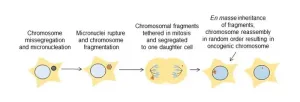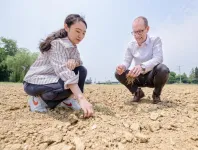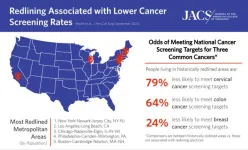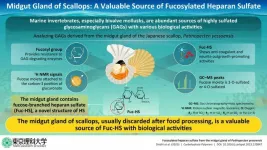(Press-News.org) Healthy cells work hard to maintain the integrity of our DNA, but occasionally, a chromosome can get separated from the others and break apart during cell division. The tiny fragments of DNA then get reassembled in random order in the new cell, sometimes producing cancerous gene mutations.
This chromosomal shattering and rearranging is called “chromothripsis” and occurs in the majority of human cancers, especially cancers of the bones, brain and fatty tissue. Chromothripsis was first described just over a decade ago, but scientists did not understand how the floating pieces of DNA were able to be put back together.
In a study published on June 14, 2023 in Nature, researchers at University of California San Diego have answered this question, discovering that the shattered DNA fragments are actually tethered together. This allows them to travel as one during cell division and be re-encapsulated by one of the new daughter cells, where they are reassembled in a different order.
“It’s similar to a smashed car windshield, where the safety glass is designed to keep all of the broken pieces in place,” said senior study author Don W. Cleveland, PhD, Distinguished Professor and chair of the Department of Cellular and Molecular Medicine at UC San Diego School of Medicine. “What we’ve done here is find the safety glass and identify several of its core components, which we can now explore as therapeutic targets.”
When chromosomes break and rearrange themselves, this can initiate or exacerbate cancer in several ways. For example, if a tumor suppressor gene is broken in the process, the cell will become more vulnerable to tumor formation. In other cases, genes that aren’t usually close to each other on the chromosome can suddenly be stitched together to produce a new oncogenic fusion protein. During chromothripsis, many such changes occur simultaneously, rather than gradually, thus accelerating cancer development or its resistance to therapy.
Now that the researchers had identified an early step in this process — the tethering of shattered DNA fragments — they wondered if they could stop it. By destroying the tether, they might prevent the rearranged chromosomes from forming, thereby reducing the number of cells potentially carrying cancerous mutations.
To do this, postdoctoral fellow and first author of the study Prasad Trivedi, PhD, engineered a modified version of one of the tether proteins so that he could induce its destruction on demand. When he did so, the tether disintegrated, the DNA fragments did not cluster and the resulting cells showed reduced survival.
The authors suggest that the proteins in this tether complex, particularly cellular inhibitor of PP2A (CIP2A), may now be an attractive therapeutic target for chromosomally unstable tumors.
“The process of chromosomal care and repair contributes to cancer in many ways, so the more we understand how it works, the better we can fine-tune it to treat cancer,” said Cleveland.
Co-authors of the study include: Christopher D. Steele, Franco K. C. Au and Ludmil B. Alexandrov, all at UC San Diego.
# # #
END
Tethering of shattered chromosomal fragments paves way for new cancer therapies
UC San Diego scientists discover shattered chromosomal fragments are tethered together during cell division before being rearranged; destroying the tether may help prevent cancerous mutations
2023-06-15
ELSE PRESS RELEASES FROM THIS DATE:
Diagnosis of rare, genetic muscle disease improved by new approach
2023-06-15
It’s not easy to distinguish between the dozens of subtypes of limb girdle muscular dystrophy — a rare, genetic muscle disease characterized by weakness in the hips and shoulders that causes difficulty walking and lifting the arms. Until now, determining the subtype has not been critical in caring for patients, because no specific treatments have been available. But gene therapies are on the horizon, and such therapies are targeted to specific genetic variants, so pinpointing the genetic roots of each patient’s disease has taken on a new importance.
In new research, a team at Washington University ...
Analysis of race and ethnicity, socioeconomic factors, and tooth decay among children
2023-06-15
About The Study: In this retrospective cohort study, large proportions of disparities in time to first tooth decay associated with race and ethnicity were explained by insurance type and dental procedure types among children and adolescents. These findings can be applied to develop targeted strategies to reduce oral health disparities.
Authors: Sung Eun Choi, S.M., Ph.D., of the Harvard School of Dental Medicine in Boston, is the corresponding author.
To access the embargoed study: Visit our For The Media website at this link https://media.jamanetwork.com/
(doi:10.1001/jamanetworkopen.2023.18425)
Editor’s ...
Prevalence of diabetic retinopathy in the US
2023-06-15
About The Study: In 2021, it is estimated that 9.6 million people in the U.S. (26% of those with diabetes) had diabetic retinopathy and 1.84 million people (5% of those with diabetes) had vision-threatening diabetic retinopathy. There was marked variation in prevalence across states and the number of people living with diabetes-related eye disease grew substantially since prevalence was last estimated in 2004 and may grow in the coming decades due to the increasing burden of diabetes among youth and adults.
Authors: Elizabeth A. Lundeen, Ph.D., of the Centers for Disease Control and Prevention in Atlanta, is the corresponding author.
To access ...
Use of wearable activity trackers to improve patient physical activity, other outcomes in adults who are hospitalized
2023-06-15
About The Study: In this systematic review and meta-analysis of 15 studies and 1,900 participants, interventions that used wearable activity trackers with patients who are hospitalized were associated with higher physical activity levels, less sedentary behavior, and better physical functioning compared with usual care.
Authors: Carol Maher, Ph.D., of the University of South Australia in Adelaide, South Australia, Australia, is the corresponding author.
To access the embargoed study: ...
Shock to the crop system
2023-06-15
As the world faces more climate variability and extremes in the face of global warming, sudden environmental changes add an extra layer of stress to food production in the United States and around the world. It is critical, then, to figure out how the areas in which crops are planted and harvested respond to these stressors, which can bring on ‘shocks’ in production – or, put differently, sudden and statistically significant crop declines.
These production shocks are a big concern in terms of food stability and many crops in the United States—such as corn, cotton, soybeans, and wheat — are all experiencing more frequent production reductions ...
Researchers demystify the unusual origin of the Geminids meteor shower
2023-06-15
The Geminids meteoroids light up the sky as they race past Earth each winter, producing one of the most intense meteor showers in our night sky.
Mysteries surrounding the origin of this meteoroid stream have long fascinated scientists because, while most meteor showers are created when a comet emits a tail of ice and dust, the Geminids stem from an asteroid — a chunk of rock that normally does not produce a tail. Until recently, the Geminids had only been studied from Earth.
Now, Princeton researchers used observations from NASA’s Parker Solar Probe mission to deduce that it was likely a violent, ...
Historic redlining practices cast a long shadow on cancer screening rates
2023-06-15
Key Takeaways
Banned since 1968, the legacy of redlining persists: There continue to be instances of discrimination affecting people in these historically redlined areas.
Redlining was associated with lower odds of hitting screening targets for all three types of cancer: 24% lower odds in breast cancer, 64% lower odds in colorectal, and 79% lower odds in cervical cancer, compared with non-redlined areas.
Actionable initiatives to improve cancer screening rates: Questionnaires to determine barriers to cancer screening, mobile cancer screening ...
Midgut gland of scallops: a valuable source of fucosylated heparan sulfate
2023-06-15
Glycosaminoglycans (GAGs), including chondroitin sulfate (CS), heparan sulfate (HS), heparin, and hyaluronan are linear and acidic polysaccharides found in the extracellular matrix of all animal tissues. GAGs are widely used as functional ingredients in health products, pharmaceuticals, and cosmetics, and are prepared from biological samples such as shark cartilage and porcine intestinal mucosa. Consequently, the demand for new sources of GAGs is ever-present. For example, the supply source of the anticoagulant heparin—generally prepared from porcine intestinal mucosa in China—was threatened by African swine fever in 2018.
GAGs derived from marine invertebrates—animals ...
University of Cincinnati research finds potential therapy for rare but devastating lung disease
2023-06-15
A treatment for a rare cancer-like lung disease found in women of childbearing age may have been discovered by University of Cincinnati researchers.
The rare lung disease is called lymphangioleiomyomatosis or LAM, and the cause of it is unknown with no cure established. New UC research, funded by the National Heart, Lung, and Blood Institute, discovered that two existing drugs show signs of being effective in treating LAM and could lead to the development of a cure.
The study was published in Science Advances,
“The exact number of women with LAM is unknown but it is estimated that for every 1 million women in the world, three to seven ...
Insilico Medicine’s transformer-based aging clock provides insights into aging, disease, and new therapeutic targets
2023-06-15
Clinical stage generative artificial intelligence (AI)-driven drug discovery company Insilico Medicine (“Insilico”) has announced a new multimodal transformer-based aging clock that is capable of processing diverse data sets and providing insights into biomarkers for aging, mapping them to genes relevant to both aging and disease, and discovering new therapeutic targets designed to slow or reverse both aging and aging-related diseases. The company calls the aging clock Precious1GPT, in a nod to the powerful “One Ring” in Lord of the Rings. The findings were published in the June 13 issue of the journal Aging.
Insilico has been ...
LAST 30 PRESS RELEASES:
Air pollution exposure and birth weight
Obstructive sleep apnea risk and mental health conditions among older adults
How talking slows eye movements behind the wheel
The Ceramic Society of Japan’s Oxoate Ceramics Research Association launches new international book project
Heart-brain connection: international study reveals the role of the vagus nerve in keeping the heart young
Researchers identify Rb1 as a predictive biomarker for a new therapeutic strategy in some breast cancers
Survey reveals ethical gaps slowing AI adoption in pediatric surgery
Stimulant ADHD medications work differently than thought
AI overestimates how smart people are, according to HSE economists
HSE researchers create genome-wide map of quadruplexes
Scientists boost cell "powerhouses" to burn more calories
Automatic label checking: The missing step in making reliable medical AI
Low daily alcohol intake linked to 50% heightened mouth cancer risk in India
American Meteorological Society announces Rick Spinrad as 2026 President-Elect
Biomass-based carbon capture spotlighted in newly released global climate webinar recording
Illuminating invisible nano pollutants: advanced bioimaging tracks the full journey of emerging nanoscale contaminants in living systems
How does age affect recovery from spinal cord injury?
Novel AI tool offers prognosis for patients with head and neck cancer
Fathers’ microplastic exposure tied to their children’s metabolic problems
Research validates laboratory model for studying high-grade serous ovarian cancer
SIR 2026 delivers transformative breakthroughs in minimally invasive medicine to improve patient care
Stem Cell Reports most downloaded papers of 2025 highlight the breadth and impact of stem cell research
Oxford-led study estimates NHS spends around 3% of its primary and secondary care budget on the health impacts of heat and cold in England
A researcher’s long quest leads to a smart composite breakthrough
Urban wild bees act as “microbial sensors” of city health.
New study finds where you live affects recovery after a hip fracture
Forecasting the impact of fully automated vehicle adoption on US road traffic injuries
Alcohol-related hospitalizations from 2016 to 2022
Semaglutide and hospitalizations in patients with obesity and established cardiovascular disease
Researchers ‘listen in’ to embryo-mother interactions during implantation using a culture system replicating the womb lining
[Press-News.org] Tethering of shattered chromosomal fragments paves way for new cancer therapiesUC San Diego scientists discover shattered chromosomal fragments are tethered together during cell division before being rearranged; destroying the tether may help prevent cancerous mutations





